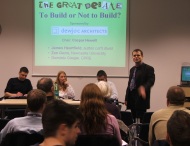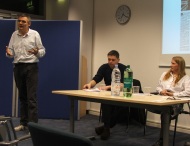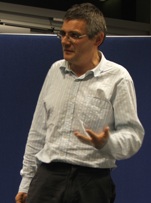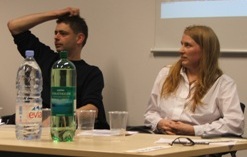To Build or not To Build?
sponsored by


 Thursday 30th November 2006
Thursday 30th November 2006
Institute for Research on Environment and Sustainability
Newcastle University
Proceedings by C J M Hewett
based on the notes of Mo Lovatt
Click here for printer friendly version of this page
The Chair, Caspar Hewett, opened the proceedings by thanking
Dewjoc Architects for their sponsorship and the
Institute for Research on Environment and Sustainability (IRES) for hosting the event.
He introduced the three speakers;
Dr Zan Gunn,
Lecturer in Town Planning, Newcastle University,
James Heartfield,
author, Let’s Build: Why We Need Five Million New Homes in the
Next Ten Years and Dominic Coupe representing the
Campaign to Protect Rural England (CPRE), inviting
them to consider the central questions of what the barriers are to providing housing
for all at the beginning of the 21st century and how and where we should be building.
 Dr Zan Gunn opened by giving an overview of the issue of whether we need to
build more housing, assuming that the other speakers would be covering points such as
‘the big demand for housing versus the low build rate’; the increase in homelessness,
increasing house prices and the impact on the countryside of new buildings. She wanted
to focus on the tension between sustainable development and the demand for new housing,
a tension which is reflected in people’s house-buying choices (location, price etc).
She pointed out that calculating the future demand for housing is based predominantly on
national population statistics which tell us
that we have an increasingly aging population; mortality rates and fertility rates. These
factors, amongst others, help us to reach projected figures for housing needs. Once the
figures have been calculated we need to decide where to put the houses - issues such as
regional priorities and land availability will have an impact on such decisions.
Dr Zan Gunn opened by giving an overview of the issue of whether we need to
build more housing, assuming that the other speakers would be covering points such as
‘the big demand for housing versus the low build rate’; the increase in homelessness,
increasing house prices and the impact on the countryside of new buildings. She wanted
to focus on the tension between sustainable development and the demand for new housing,
a tension which is reflected in people’s house-buying choices (location, price etc).
She pointed out that calculating the future demand for housing is based predominantly on
national population statistics which tell us
that we have an increasingly aging population; mortality rates and fertility rates. These
factors, amongst others, help us to reach projected figures for housing needs. Once the
figures have been calculated we need to decide where to put the houses - issues such as
regional priorities and land availability will have an impact on such decisions.
Gunn drew attention to the fact that in 2000 housing policy encouraged urban development and
concentrated locations of development, rather than sporadic, spread-out development. However,
the position has shifted somewhat since then. Although urban development is still the first
priority, there is more emphasis on mixed development, development in the North to encourage
growth, development in the South to meet demand. Affordable housing and the desire for
more owner-occupied housing are also large priorities in forming policy. The issue of people
buying to let is also a concern. She pointed out that, in addition to this, there are a number
of value judgements that need to be made. People’s choices are important: the area we want to
live in, length of tenure times, wanting more land, wanting more rooms in a house and meeting
the needs of our travel patterns are all considerations and policy will reflect these.
 The second speaker, James Heartfield, began by restating the proposition of his book
Let’s Build that we need 5 milllion new homes in the next 10 years. There are two major
reasons, one of which is reflected in the discussion about policy and one of which is not.
First, demand is increasing. Immigration is rising and there is a change in the character
of our society which means we need more housing: we are living in smaller families and there
is a big increase in single-person households. One reason for this is that women are now big
wage earners in society, therefore there are more and more people seeking mortgages. He
commented that kicking women out of the workplace would reduce housing demand, but did not
think that could be considered an agreeable option. He argued that the increasing demand for
housing is a good thing, seeing it as a product of a positive aspect of our changing society.
However, we are not meeting that demand, 150,000 houses are being built each year which is
not even sufficient to replenishing our stock of housing. It is estimated that if we
continue with this slow build rate we will need our current stock of housing to be still
standing for the next 1,500 years, something which is clearly not a realistic proposition.
The second speaker, James Heartfield, began by restating the proposition of his book
Let’s Build that we need 5 milllion new homes in the next 10 years. There are two major
reasons, one of which is reflected in the discussion about policy and one of which is not.
First, demand is increasing. Immigration is rising and there is a change in the character
of our society which means we need more housing: we are living in smaller families and there
is a big increase in single-person households. One reason for this is that women are now big
wage earners in society, therefore there are more and more people seeking mortgages. He
commented that kicking women out of the workplace would reduce housing demand, but did not
think that could be considered an agreeable option. He argued that the increasing demand for
housing is a good thing, seeing it as a product of a positive aspect of our changing society.
However, we are not meeting that demand, 150,000 houses are being built each year which is
not even sufficient to replenishing our stock of housing. It is estimated that if we
continue with this slow build rate we will need our current stock of housing to be still
standing for the next 1,500 years, something which is clearly not a realistic proposition.
Heartfield highlighted the usual argument against his proposition, which is that there is
not enough green land on which to build, yet only 10% of the country is built-up while
90% is green.
Showing some of the great estates owned by prominent members of the CPRE, he argued that
the CPRE take this view because they do not want the rest of us, ‘the oiks,’ to encroach
on their area. In addition, he pointed out that three quarters of this green area is
farmland, one third of which is surplus to requirement. In fact, there are government
policies specifically formulated
to encourage this third to be converted back to non-farmland. He concluded by saying that
we do not need to save the countryside for the elite – there is plenty of green land to go
around!
Dominic Coupe began by contradicting Heartfield’s description of the CPRE. He stated
that that the bulk of the CPRE’s work is about getting it right in towns and cities, not
just protecting rural England. He argued that it is quite clear, especially when you
consider that it took him 4 hours to drive the 7 miles to Newcastle for this event, that we
are not getting it right at present. Again, contrary to Heartfield’s suggestion, the CPRE
do not suggest that all the housing requirements should be in cities; however they do ask
pertinent questions about building on previously developed land in preference to greenfield
sites and about regenerating the 700,000 empty properties that are not being used? He also
drew attention to an alternative statistic that had not been quoted by the other speakers:
the fact that the first-time buyer rates are going down.
For Coupe there are many options to consider, including building on brownfield sites, but
these do not necessarily preclude building onto our countryside – which he was keen to
remind the audience is enjoyed by city-dwellers as well as people like himself who ’live
in trees’. He stated that the CPRE does see the benefit of creating a vibrant economy in
the countryside and considers that the way to do this is to create jobs - and with jobs
comes the need for housing, which the CPRE do recognise. He closed by saying that the CPRE
welcomes PPS3 because it discusses development in the countryside, but in the right way.
The chair then invited the speakers to respond to each other’s introductions.
Observing that the other two speakers agree that more housing is necessary; and that
some of it will be in the countryside, Zan Gunn wanted to know how we afford it
and whether we have a building industry that can support the quoted demand of 5 million
homes in 10 years. She also felt that there are other questions regarding the cost of
infrastructure and managing the North-South divide which had not been addressed yet.
James Heartfield drew attention to the two arguments he hears most frequently
against building more housing: the aesthetic argument and the problem of providing the
necessary infrastructure. He argued that the aesthetic argument is nonsense. For example
the idea that ‘housing looks ugly from the air’ is laughable. It may be true that when we
sit in an aeroplane and look down on developed areas they do not look as aesthetically
pleasing as the countryside, but as we do not live in the air, this argument should be
discounted. He also thought that the infrastructure provision argument is also not a good
argument, arguing that infrastructure always following building, so we should be building
houses and infrastructure.
Dominic Coupe responded that building infrastructure is not necessarily the solution.
People living in the countryside can find alternatives. For example, you can find natural
drinking water sources which can also be used for household water requirements. It is also
possible to generate your own electricity/power sources. However Coupe thought that we do
need to consider infrastructure, but we need to get the infrastructure right, before we
build more houses.
The chair opened the discussion to the other participants, inviting questions and points
from the floor. Some questions arose regarding infrastructure provision and building
capacity. One attendee argued that we already pay through the nose for the
infrastructure we have and for repairs to an aging infrastructure, asking why we should
pay more. Another participant wanted to know where the money would come from for building
new housing and infrastructure. Zan Gunn emphasised that she was not arguing
against infrastructural development, but rather was saying that the scale needs to be
considered, both in terms of cost and capacity to build it. John Burns, architect,
quoted
government policy which states that we need to build 170,000 new houses per year, yet only
145,000 were built last year. This does not even match the current rate of immigration.
He contended that the building industry could support higher demand but perhaps would not
have the capacity to build 5 million homes in 10 years. James Heartfield thought
that the question of where the money for building comes from was strange when you consider
that money in housing is inert. He pointed out that new housing is a tiny proportion of
the housing market, meaning that vast amounts of money are going into second-hand housing.
House prices are artificially high because of the housing shortfall, and this is all too
clear if you compare the rebuild costs on a buildings insurance policy to the price of
buying a house. If there were sufficient building then house prices would be much more
reasonable. On the question of planning Zan Gunn pointed out that in the 1960s
Britain had a national building programme which has since been lost, and this has
contributed to the housing shortfall.
Kevin Yuill of Sunderland University, who described himself as an interloper
and historian, wanted to
know if timber-built housing might be the answer. A timber house can be built remarkably
quickly and in Canada there are even competitions involving how quickly a house can be built.
Yet in England you cannot get a mortgage for a timber-built house (one participant
interjected that you can in Scotland). Replenishing housing stock and infrastructure is
expensive, but prices would come down if we built with timber. Dominic Coupe
also wanted to know why timber-building is not an option in England. Ian Abley
of Audacity thought it was because there is no decent timber grown in the UK,
to which Dominic Coupe replied that we should ship it over from Scandinavia.
Sean Wilkinson, lecturer in structural engineering at Newcastle University, comes
from Australia and what he loves about England is the easy access to the countryside.
Thus he thinks that Green Belts are a good thing. However he felt that the price of
housing is a real problem and there is no doubt that more housing is needed. Thus he was
interested in whether the panel would build on pristine countryside or Green Belts.
In contrast Kevin Yuill wanted to know who actually benefits from Green Belts,
asking why we do not just get rid of them if we need more space.
James Heartfield wanted to see building on both pristine countryside and Green
Belts. He argued that Green Belts do not benefit anyone so much as they disfavour some:
they are a means to keep the ‘oiks’ out and were designed to be anti-town-expansion devices.
Zan Gunn thought that where houses are built should depend simply upon where the
need is, but she was in favour of small scale building in pristine countryside. Dominic
Coupe was strongly in favour of keeping Green Belts. They stop towns merging into one
another and aid access between the town and the country – in both directions. Giving the
example of Northumberland, in which there are vast areas of sparsely populated countryside,
he argued that a huge proportion of the population of Newcastle could be accommodated in
what is now countryside, thus he would definitely go for pristine sites. He went on to
suggest that nobody, not even the small number of people living in sparsely populated areas,
would notice if you built a new town for 25,000 people in the heart of Kielder forest.
One participant posed the question of what pristine countryside is, arguing that almost
nothing about our countryside is natural. For example, many areas are undergoing natural
re-forestation, but this is discouraged and they are cut down because it is not what
tourists want. He went on to argue that the countryside is not useful. Dominic Coupe
disagreed, saying that it is useful because it is tranquil and beautiful, to which the
participant replied that if we had better living conditions in the first place we would not
need to seek tranquillity in the country - we only need the countryside to escape from the
way we live today.
A number of points were made about the type of space people want to live in,
particularly with reference to housing density. Paul, a housing architect pointed
out
that on average in England houses are a half to two-thirds of the size of houses in
Europe. The cost of land in England makes it almost impossible for most people to
consider building their own home (something that is quite common in Europe) - in Darras
Hall land costs £2,000,000 per acre. He argued that we should have the human right to a
certain square acreage or to choose how we want to live and that the Government owes its
people the right to live a better quality of life. One participant thought that ‘walkable
neighbourhoods’ might be the answer to the density issue.
Mark Shucksmith of the Planning Department at Newcastle University thought that the
reason land prices are so high should be examined. According to post-war estimates they
should not be as high as they are. He asked if they could be lower and whether incentives
could be found to make house building more profitable. Regarding density rates,
Shucksmith pointed out that in the last three years building rates have been up 10 to 20%
in urban areas while they have been down 3 to 4% in the countryside. He wondered if this is
to do with regional spatial strategies.
Ian Abley felt that the planning regulations and the freehold issue in particular
were more pertinent than the human right to a certain square footage. He argued that the
rules for planning permission introduced in 1947 are out of date and represent a denial of
our freedom to build. They are also the root cause of the ridiculously high price of land.
Manufacturers in the North East of England were leaders in pre-fabricated housing, but were
put out of business by planning regulations. On the question of space, Abley wanted to know
if CPRE supports low-density development. Dominic Coupe quoted CPRE’s recommended
density rate, which is 30-50 homes per hectare. Coupe was also critical of the planning
regulations ridiculing the fact that, until recently, old farm buildings could only be
converted for the purpose of tourism. Old stable buildings are also lying empty, they are
not used in modern farming and are easily convertible into housing. James Heartfield
made the point that there is no need for people to live densely even in the South East of
England. There is plenty of land, just a problem with building on it.
Francis Graves, Architect and teacher at Newcastle University
wanted to talk about suburbia. He was all for enhancing dynamic town and a
dynamic countryside, but not for an ever-sprawling suburbia. He argued that the
country (i.e., the UK) is becoming more urban and objected to the fact that people are
moving to the commuter belt. James Heartfield thought that the notion of a
clear distinction between town and country was out of date, representing a 19th Century
view of the country. Many rural dwellers today are ex-urbanites or ex-suburbanites.
Thus ‘town’ and ‘country’ are redundant terms. He pointed out that life in the suburbs
is the choice for the majority of people and that yesterday’s suburbs are today’s urban
developed areas, for instance Notting Hill in London. Most importantly for Heartfield,
we do not know where people actually want to live because we have not asked them.
We rely on top-down directives which make assumptions about people’s choices.
Heartfield would like to see some chances taken, rejecting the idea of constraining
people’s needs and choices. Hence the title of his book, Let’s Build. It is only
if we build and make mistakes that we will learn how to ‘get it right’.
 Some more general questions arose around the issues of sustainability
and carbon dioxide emissions. Zan Gunn and Dominic
Coupe agreed that the sustainability of a proposed building programme should be a
consideration. James Heartfield thought that there is a problem with Sustainable
Development in that it creates a confusion over which natural resources we want to
protect, which is a barrier to moving forwards. For instance, carbon dioxide
emissions would be reduced if we built on Green Belts; a great deal of energy is
wasted trying to regenerate old homes rather than building new, efficient ones, but
this fact clashes with the desire to save particular areas of land. Mark Shucksmith
drew attention to the Stern Report which stated that 49% of carbon dioxide emissions
come from buildings. Thus he wondered what figure of upgraded stock should be you
recommended. Ian Abley argued that our sense of ourselves in the world is askew,
especially in relation to carbon emissions. If we look at China’s current rate of
development and carbon dioxide emissions then Britain’s output is almost irrelevant.
Dominic Coupe made the point that carbon dioxide is not all bad:
trees live on it and they live in the country.
Some more general questions arose around the issues of sustainability
and carbon dioxide emissions. Zan Gunn and Dominic
Coupe agreed that the sustainability of a proposed building programme should be a
consideration. James Heartfield thought that there is a problem with Sustainable
Development in that it creates a confusion over which natural resources we want to
protect, which is a barrier to moving forwards. For instance, carbon dioxide
emissions would be reduced if we built on Green Belts; a great deal of energy is
wasted trying to regenerate old homes rather than building new, efficient ones, but
this fact clashes with the desire to save particular areas of land. Mark Shucksmith
drew attention to the Stern Report which stated that 49% of carbon dioxide emissions
come from buildings. Thus he wondered what figure of upgraded stock should be you
recommended. Ian Abley argued that our sense of ourselves in the world is askew,
especially in relation to carbon emissions. If we look at China’s current rate of
development and carbon dioxide emissions then Britain’s output is almost irrelevant.
Dominic Coupe made the point that carbon dioxide is not all bad:
trees live on it and they live in the country.
The debate revealed a surprising consensus across the panel and audience about the need
for a massive building programme, and indeed there was little disagreement over numbers.
Dominic Coupe recognised this explicitly, explaining that when he talked about
‘new homes’ he was talking about ‘net new homes’, while James Heartfield’s estimate of
500,000 a year refers to ‘total new homes’. Thus the CPRE’s and Heartfield’s figures
are probably quite similar. Asked for their closing remarks Dominic Coupe thought
that we ought to be following the European model of renting rather than buying, Zan
Gunn commented that the need is undeniable, but it is how we meet that need that is
important. James Heartfield did not mind how houses are built, be it by government
or private companies (although he pointed out that social housing is not a popular choice
for people today) but emphasised that we need to build a lot more than we are at present.
Caspar J M Hewett, Jan 2007
Top of page


 Thursday 30th November 2006
Thursday 30th November 2006
 Dr Zan Gunn opened by giving an overview of the issue of whether we need to
build more housing, assuming that the other speakers would be covering points such as
‘the big demand for housing versus the low build rate’; the increase in homelessness,
increasing house prices and the impact on the countryside of new buildings. She wanted
to focus on the tension between sustainable development and the demand for new housing,
a tension which is reflected in people’s house-buying choices (location, price etc).
She pointed out that calculating the future demand for housing is based predominantly on
national population statistics which tell us
that we have an increasingly aging population; mortality rates and fertility rates. These
factors, amongst others, help us to reach projected figures for housing needs. Once the
figures have been calculated we need to decide where to put the houses - issues such as
regional priorities and land availability will have an impact on such decisions.
Dr Zan Gunn opened by giving an overview of the issue of whether we need to
build more housing, assuming that the other speakers would be covering points such as
‘the big demand for housing versus the low build rate’; the increase in homelessness,
increasing house prices and the impact on the countryside of new buildings. She wanted
to focus on the tension between sustainable development and the demand for new housing,
a tension which is reflected in people’s house-buying choices (location, price etc).
She pointed out that calculating the future demand for housing is based predominantly on
national population statistics which tell us
that we have an increasingly aging population; mortality rates and fertility rates. These
factors, amongst others, help us to reach projected figures for housing needs. Once the
figures have been calculated we need to decide where to put the houses - issues such as
regional priorities and land availability will have an impact on such decisions.

 Some more general questions arose around the issues of sustainability
and carbon dioxide emissions. Zan Gunn and Dominic
Coupe agreed that the sustainability of a proposed building programme should be a
consideration. James Heartfield thought that there is a problem with Sustainable
Development in that it creates a confusion over which natural resources we want to
protect, which is a barrier to moving forwards. For instance, carbon dioxide
emissions would be reduced if we built on Green Belts; a great deal of energy is
wasted trying to regenerate old homes rather than building new, efficient ones, but
this fact clashes with the desire to save particular areas of land. Mark Shucksmith
drew attention to the Stern Report which stated that 49% of carbon dioxide emissions
come from buildings. Thus he wondered what figure of upgraded stock should be you
recommended. Ian Abley argued that our sense of ourselves in the world is askew,
especially in relation to carbon emissions. If we look at China’s current rate of
development and carbon dioxide emissions then Britain’s output is almost irrelevant.
Dominic Coupe made the point that carbon dioxide is not all bad:
trees live on it and they live in the country.
Some more general questions arose around the issues of sustainability
and carbon dioxide emissions. Zan Gunn and Dominic
Coupe agreed that the sustainability of a proposed building programme should be a
consideration. James Heartfield thought that there is a problem with Sustainable
Development in that it creates a confusion over which natural resources we want to
protect, which is a barrier to moving forwards. For instance, carbon dioxide
emissions would be reduced if we built on Green Belts; a great deal of energy is
wasted trying to regenerate old homes rather than building new, efficient ones, but
this fact clashes with the desire to save particular areas of land. Mark Shucksmith
drew attention to the Stern Report which stated that 49% of carbon dioxide emissions
come from buildings. Thus he wondered what figure of upgraded stock should be you
recommended. Ian Abley argued that our sense of ourselves in the world is askew,
especially in relation to carbon emissions. If we look at China’s current rate of
development and carbon dioxide emissions then Britain’s output is almost irrelevant.
Dominic Coupe made the point that carbon dioxide is not all bad:
trees live on it and they live in the country.